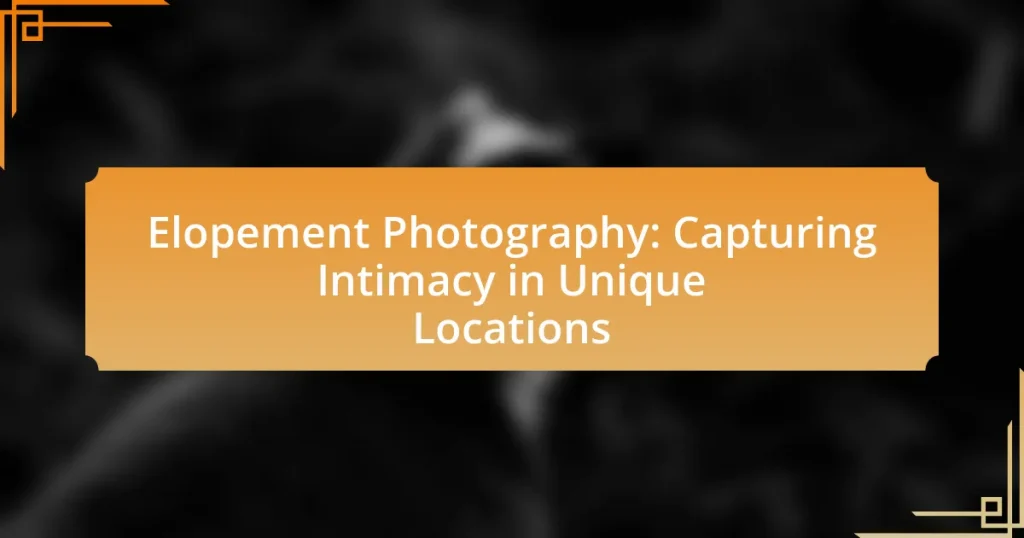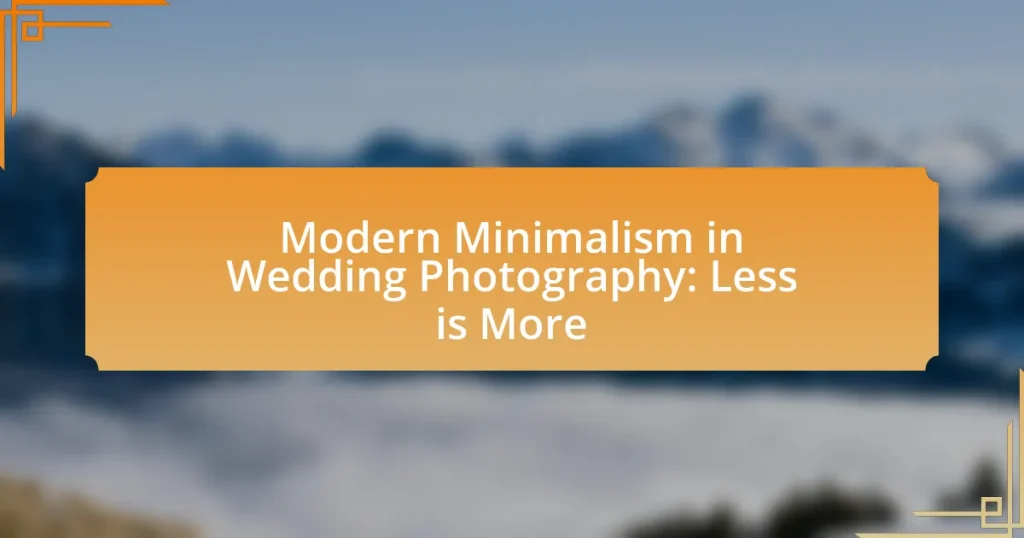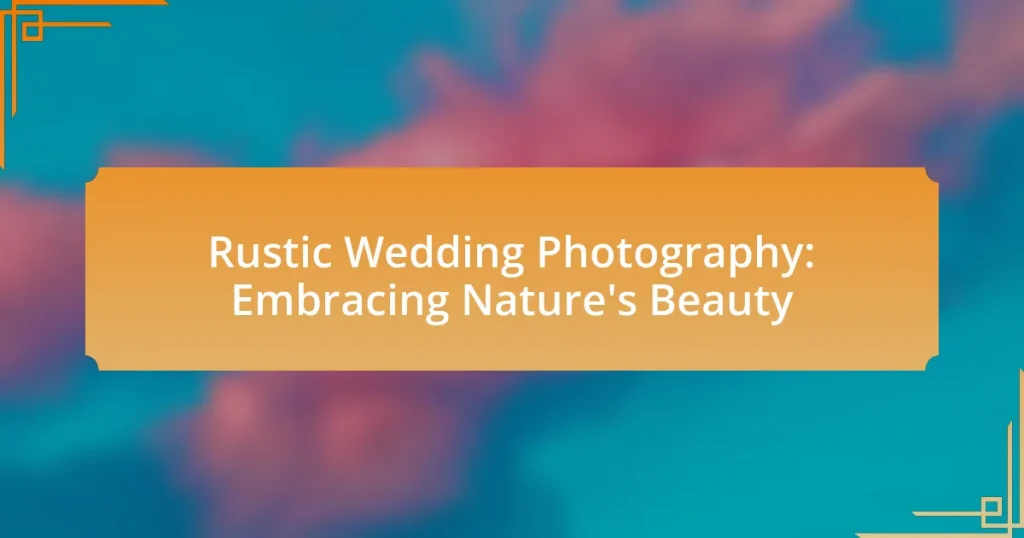Elopement photography is a specialized genre that captures intimate moments between couples who choose to marry in private settings, often away from traditional venues. This article explores the differences between elopement and traditional wedding photography, highlighting the unique elements that define this style, such as spontaneity, personalized storytelling, and the significance of location. It also discusses the growing popularity of elopements, driven by cultural shifts towards valuing intimate experiences, and provides insights into planning, techniques, and challenges associated with elopement photography. Key aspects include the impact of location on emotional tone, essential equipment, and strategies for managing time and weather conditions during shoots.
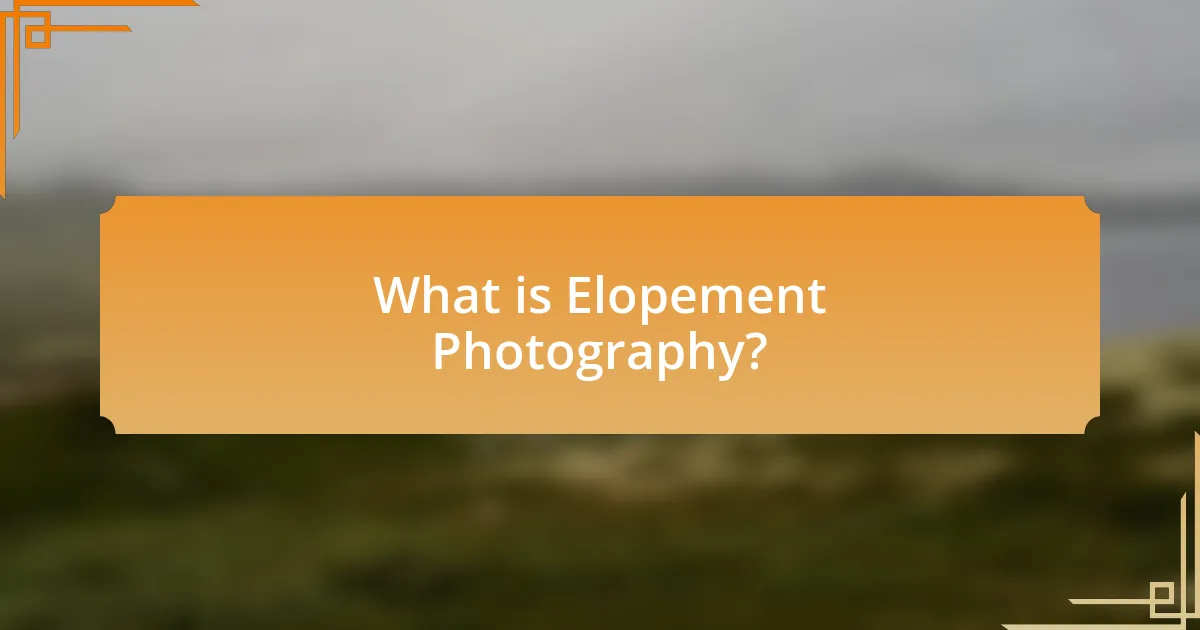
What is Elopement Photography?
Elopement photography is a specialized genre of photography that focuses on capturing intimate moments between couples who choose to marry in a private setting, often away from traditional wedding venues. This type of photography emphasizes the couple’s connection and the unique locations they select, which can range from scenic outdoor landscapes to urban backdrops. The rise in popularity of elopements, particularly in recent years, is supported by a growing trend where couples prioritize personal experiences over large gatherings, leading to an increase in demand for photographers skilled in this intimate style.
How does Elopement Photography differ from traditional wedding photography?
Elopement photography differs from traditional wedding photography primarily in its focus on intimate, private ceremonies rather than large, formal celebrations. Elopement photography typically captures spontaneous moments in unique locations, emphasizing the couple’s connection and personal experience, while traditional wedding photography often involves staged events with extensive guest lists, formal settings, and structured timelines. This distinction is evident as elopements usually require fewer logistical considerations, allowing photographers to explore creative angles and settings that reflect the couple’s personality, whereas traditional weddings often adhere to conventional poses and group shots.
What unique elements define Elopement Photography?
Elopement photography is defined by its focus on intimate, personal moments captured in unique and often remote locations. This style emphasizes spontaneity and authenticity, allowing couples to express their love in settings that resonate with their personal story. Unlike traditional wedding photography, elopement photography often features fewer guests, which enhances the emotional connection between the couple and the photographer. The choice of location is crucial, as it often reflects the couple’s personality and preferences, ranging from breathtaking landscapes to urban backdrops. This approach allows for creative storytelling through imagery, capturing candid moments that highlight the couple’s relationship in a way that is both artistic and genuine.
How does the intimacy of elopements influence photography style?
The intimacy of elopements significantly influences photography style by encouraging a focus on candid, emotional moments rather than posed shots. This intimate setting allows photographers to capture genuine interactions between the couple, emphasizing their connection and the personal nature of their vows. For instance, elopements often take place in secluded or meaningful locations, which enhances the storytelling aspect of the images, as the backdrop complements the couple’s unique narrative. Additionally, the smaller scale of elopements permits photographers to experiment with close-up shots and creative angles, resulting in a more personal and artistic representation of the event.
Why is Elopement Photography gaining popularity?
Elopement photography is gaining popularity due to the increasing desire for intimate, personalized wedding experiences. Couples are opting for smaller, more meaningful ceremonies in unique locations, which elopement photography captures beautifully. This trend is supported by statistics showing that elopements have risen by over 50% in recent years, as couples seek to prioritize their relationship over traditional wedding expectations. The focus on authenticity and emotional connection in these settings resonates with modern couples, making elopement photography a preferred choice for documenting their special moments.
What cultural shifts are contributing to the rise of elopements?
The rise of elopements is primarily driven by cultural shifts towards prioritizing personal experiences over traditional expectations. Increasingly, couples are valuing intimacy and authenticity in their wedding celebrations, opting for smaller, more meaningful ceremonies that reflect their unique love stories. This trend is supported by the growing acceptance of non-traditional relationships and the desire to escape the pressures of large, conventional weddings, which often involve significant financial and social obligations. Additionally, the influence of social media has popularized elopements, showcasing diverse and picturesque locations that inspire couples to choose intimate settings over grand venues.
How do couples benefit from choosing elopement photography?
Couples benefit from choosing elopement photography by capturing intimate moments in unique locations, which enhances their personal experience and memories. This type of photography allows couples to focus on each other without the distractions of a traditional wedding, resulting in authentic and emotional images. Additionally, elopement photography often takes place in breathtaking settings, providing stunning backdrops that elevate the visual storytelling of their love. The personalized nature of elopement photography also means that couples can tailor their sessions to reflect their personalities and relationship, leading to a more meaningful and memorable collection of photographs.
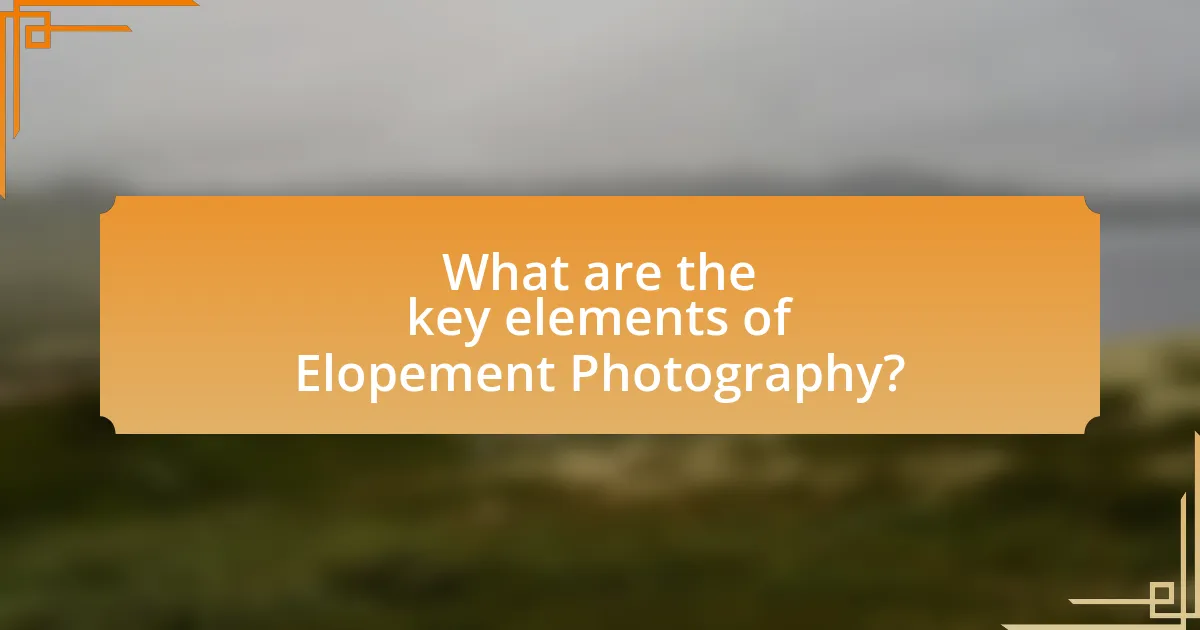
What are the key elements of Elopement Photography?
The key elements of elopement photography include intimate settings, candid moments, and personalized storytelling. Intimate settings often feature unique locations that reflect the couple’s personality, such as scenic landscapes or urban backdrops. Candid moments capture genuine emotions and interactions between the couple, emphasizing their connection. Personalized storytelling involves documenting the couple’s journey and experiences, often incorporating details like vows, rings, and personal touches that make the day special. These elements collectively create a narrative that highlights the couple’s love in a meaningful way.
How do location choices impact Elopement Photography?
Location choices significantly impact elopement photography by influencing the aesthetic, mood, and emotional resonance of the images captured. Unique locations, such as scenic landscapes or intimate urban settings, provide distinct backdrops that enhance the couple’s story and the overall visual narrative. For instance, a mountain vista can evoke feelings of adventure and freedom, while a cozy beach setting may convey romance and tranquility. Research indicates that 70% of couples prioritize location when planning their elopement, as it directly affects the composition and emotional depth of the photographs. Therefore, selecting a meaningful and visually appealing location is crucial for creating memorable and impactful elopement photography.
What are some popular unique locations for elopements?
Some popular unique locations for elopements include the stunning landscapes of Iceland, the picturesque beaches of Maui, and the enchanting forests of the Pacific Northwest. Iceland offers dramatic backdrops with its waterfalls and glaciers, making it a favorite for couples seeking adventure and beauty. Maui’s beaches provide a romantic setting with breathtaking sunsets and lush scenery. The Pacific Northwest features dense forests and rugged coastlines, ideal for couples who appreciate nature’s tranquility. These locations are frequently chosen for their distinctive charm and ability to create intimate, memorable experiences.
How can the environment enhance the emotional tone of the photos?
The environment can enhance the emotional tone of photos by providing context, mood, and atmosphere that resonate with the subjects’ feelings. For instance, a serene beach at sunset can evoke feelings of romance and tranquility, while a rugged mountain landscape can convey adventure and strength. Specific elements such as lighting, colors, and natural features contribute to the overall emotional impact; studies show that warm colors can elicit feelings of warmth and happiness, while cooler tones may evoke calmness or sadness. Therefore, the choice of environment directly influences the emotional narrative captured in elopement photography.
What role does planning play in successful Elopement Photography?
Planning is crucial for successful elopement photography as it ensures that all logistical aspects are addressed, allowing for a seamless experience. Effective planning involves selecting the right location, understanding the couple’s vision, and coordinating timing for optimal lighting conditions. For instance, a well-planned elopement shoot can take advantage of golden hour lighting, which enhances the quality of photographs. Additionally, thorough preparation helps in anticipating potential challenges, such as weather changes or access issues, thereby minimizing stress on the couple and the photographer. This structured approach ultimately leads to capturing intimate moments in unique locations, fulfilling the couple’s desires for their special day.
How can couples effectively plan their elopement photography session?
Couples can effectively plan their elopement photography session by selecting a meaningful location, hiring a professional photographer experienced in elopements, and creating a detailed timeline for the day. Choosing a location that resonates with the couple’s story enhances the emotional impact of the photos, as studies show that personal connections to a setting can lead to more authentic expressions during the shoot. Engaging a photographer who specializes in elopement photography ensures that they understand the unique dynamics and intimacy of such sessions, which is crucial for capturing genuine moments. Additionally, establishing a timeline helps in coordinating the shoot with natural lighting and any specific activities the couple wishes to include, thereby maximizing the quality of the photographs.
What should couples communicate to their photographer before the shoot?
Couples should communicate their vision, preferred styles, and specific locations to their photographer before the shoot. This includes discussing any particular shots they desire, the overall mood they want to convey, and any important details about the elopement setting that may influence the photography, such as lighting conditions or unique features of the location. Clear communication ensures that the photographer can align their approach with the couple’s expectations, leading to a more personalized and satisfying photography experience.
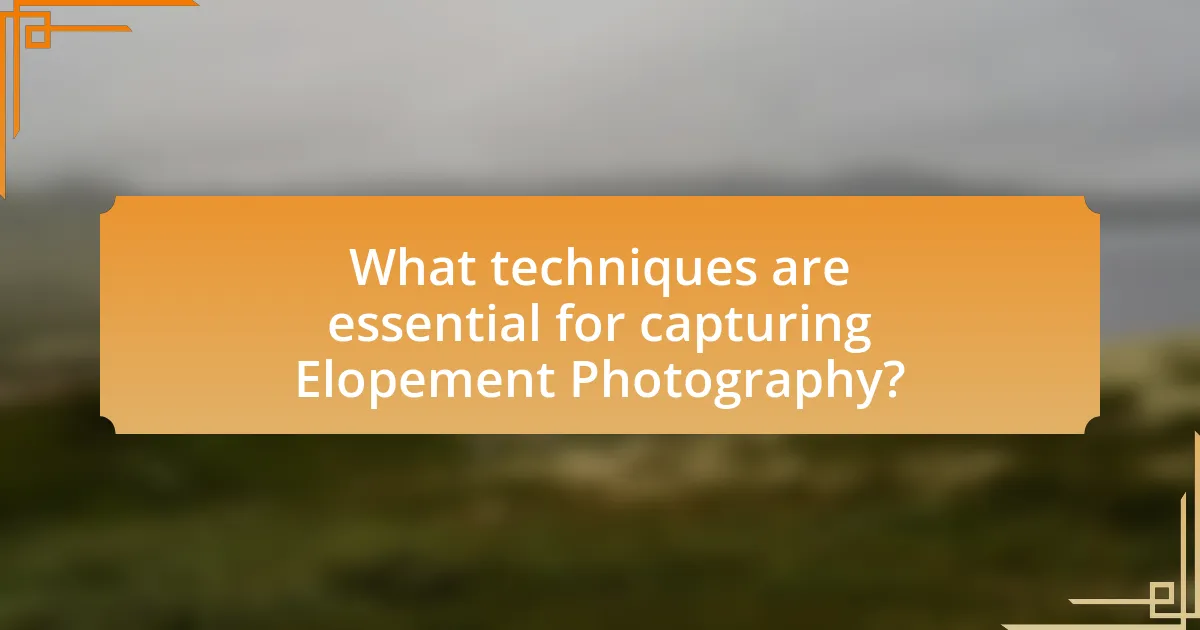
What techniques are essential for capturing Elopement Photography?
Essential techniques for capturing elopement photography include understanding natural light, composing intimate shots, and utilizing candid moments. Natural light enhances the emotional tone of the images, as soft, diffused light during golden hour creates a romantic atmosphere. Composing intimate shots involves framing the couple in a way that emphasizes their connection, often using close-ups or unique angles to highlight their emotions. Additionally, capturing candid moments allows for authentic expressions and interactions, which are crucial in conveying the intimacy of the elopement experience. These techniques collectively ensure that the essence of the couple’s unique location and their relationship is effectively documented.
How can photographers create a sense of intimacy in their shots?
Photographers can create a sense of intimacy in their shots by using close framing and capturing candid moments. Close framing allows the viewer to focus on the subjects’ expressions and interactions, enhancing emotional connection. Candid moments, which are often spontaneous and unposed, reveal genuine emotions and relationships, making the viewer feel like a part of the scene. Research indicates that images with emotional content, such as laughter or tenderness, evoke stronger feelings of intimacy in viewers, as demonstrated in studies on emotional resonance in photography.
What composition techniques work best for elopement photography?
The best composition techniques for elopement photography include the use of leading lines, framing, and the rule of thirds. Leading lines guide the viewer’s eye toward the couple, enhancing the sense of intimacy and connection in the image. Framing involves using natural elements, such as trees or arches, to create a visual border around the couple, emphasizing their relationship within the environment. The rule of thirds helps in positioning the couple off-center, creating a more dynamic and engaging composition. These techniques are effective because they draw attention to the couple while incorporating the unique surroundings, which is essential in elopement photography that aims to capture both intimacy and location.
How can lighting be used to enhance the mood of elopement photos?
Lighting can significantly enhance the mood of elopement photos by creating atmosphere and emphasizing emotions. Soft, natural light during golden hour, which occurs shortly after sunrise or before sunset, provides a warm and romantic glow that flatters subjects and adds depth to images. Conversely, dramatic lighting, such as backlighting or shadows, can evoke a sense of mystery or intimacy, making the couple appear more connected. Studies in photography show that the quality of light affects the emotional response of viewers, with softer light often associated with feelings of warmth and love, while harsher light can create tension or drama.
What equipment is recommended for Elopement Photography?
For elopement photography, a recommended equipment list includes a high-quality DSLR or mirrorless camera, versatile lenses (such as a 24-70mm for versatility and a 50mm for portraits), a sturdy tripod for stability, and external flash for low-light situations. Additionally, a drone can enhance aerial shots of unique locations, while extra batteries and memory cards ensure uninterrupted shooting. This equipment is essential for capturing the intimate moments and stunning landscapes typical of elopements, as professional photographers often rely on these tools to deliver high-quality images in diverse environments.
What camera settings are ideal for capturing elopements in various locations?
The ideal camera settings for capturing elopements in various locations typically include a wide aperture (f/1.8 to f/4) for shallow depth of field, a shutter speed of at least 1/200 seconds to freeze motion, and an ISO setting that balances exposure without introducing noise, usually between 100 and 800 depending on lighting conditions. These settings allow for beautiful, intimate portraits while accommodating different environments, such as bright outdoor settings or dimly lit venues. For instance, in bright sunlight, a lower ISO and faster shutter speed prevent overexposure, while in shaded or indoor locations, a higher ISO may be necessary to maintain clarity and detail.
How can additional gear improve the quality of elopement photos?
Additional gear can significantly enhance the quality of elopement photos by providing photographers with advanced tools to capture better images in diverse environments. For instance, using a high-quality lens can improve sharpness and depth of field, allowing for stunning portraits against scenic backdrops. Additionally, employing stabilizers or gimbals can reduce camera shake, resulting in smoother video footage and clearer images, especially in dynamic settings. Furthermore, external lighting equipment can help illuminate subjects in low-light conditions, ensuring that details are not lost in shadows. These enhancements lead to more visually appealing and professionally polished photographs, which are crucial for capturing the intimate moments of elopements.
What are some common challenges in Elopement Photography?
Common challenges in elopement photography include unpredictable weather, limited time for capturing moments, and logistical issues related to remote locations. Unpredictable weather can affect lighting and the overall atmosphere, making it difficult to achieve the desired aesthetic. Limited time often arises because elopements are typically brief, requiring photographers to work quickly to capture essential moments. Logistical issues, such as accessibility to unique locations, can complicate the planning process and may require additional equipment or permits. These challenges necessitate careful preparation and adaptability to ensure successful outcomes in elopement photography.
How can photographers prepare for unpredictable weather conditions?
Photographers can prepare for unpredictable weather conditions by utilizing weather forecasting tools and packing essential gear. By checking reliable weather apps or websites, photographers can stay informed about potential changes in weather patterns, allowing them to adjust their plans accordingly. Additionally, carrying waterproof camera bags, lens covers, and portable umbrellas ensures that equipment remains protected from rain or sudden weather shifts. Studies show that being prepared with the right gear can significantly reduce equipment damage and enhance the ability to capture quality images in varying conditions.
What strategies can be employed to manage time effectively during elopements?
To manage time effectively during elopements, couples should create a detailed timeline that outlines each segment of the day, including travel, ceremony, and photography sessions. This structured approach allows for better coordination and minimizes delays. Research indicates that having a clear schedule can reduce stress and enhance the overall experience, as it ensures that all essential moments are captured without feeling rushed. Additionally, couples should communicate with their photographer about preferred locations and time constraints, allowing for efficient planning and execution of the shoot.
What tips can enhance the Elopement Photography experience?
To enhance the Elopement Photography experience, couples should prioritize selecting meaningful locations that resonate with their relationship. Choosing unique and intimate settings, such as a favorite hiking trail or a secluded beach, can create a personal backdrop that reflects their story. Additionally, hiring a photographer experienced in elopement shoots ensures that they understand how to capture candid moments and emotions effectively. According to a survey by The Knot, 80% of couples reported that their photographer’s ability to make them feel comfortable significantly improved their overall experience. Lastly, planning the shoot during golden hour, when natural light is soft and flattering, can enhance the quality of the photographs, making them more visually appealing.
How can couples ensure they feel comfortable in front of the camera?
Couples can ensure they feel comfortable in front of the camera by engaging in pre-shoot communication with their photographer to discuss expectations and preferences. This dialogue helps establish trust and allows the photographer to tailor the session to the couple’s comfort levels. Additionally, practicing poses and expressions in a relaxed environment prior to the shoot can alleviate anxiety. Research indicates that familiarity with the camera and the photographer can significantly reduce stress, leading to more natural and authentic images.
What are best practices for selecting a photographer for elopement sessions?
The best practices for selecting a photographer for elopement sessions include reviewing their portfolio, ensuring they have experience with elopements, and checking client testimonials. A photographer’s portfolio showcases their style and ability to capture intimate moments, which is crucial for elopement photography. Experience with elopements is important because these sessions often require adaptability to unique locations and spontaneous moments. Client testimonials provide insight into the photographer’s professionalism and reliability, which are essential for a successful elopement.
